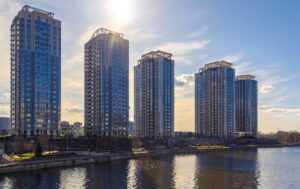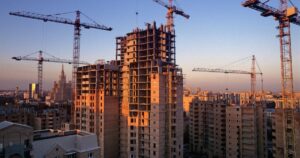
The average price on the primary market at the end of 2025 was $2,011 per square meter, or 84,600 UAH per square meter, an increase of 3.3% in dollar terms over the year, according to a press release from City One Development to Interfax-Ukraine.
According to the company’s analytical report, 2025 was a year of quiet recovery without any sharp movements for the primary residential real estate market in Kyiv.
“In fact, the market went through two different phases. At the beginning of the year, demand remained subdued: buyers took a wait-and-see position, which led to a slight (-1.2%) price adjustment. However, the second half of the year showed a change in sentiment – the number of transactions increased, and prices returned to a smooth increase (on average, they rose by 4.5%). As a result, 2025 ended with a moderate (+3.3%) increase,” said City One Development analyst Olena Shirina.
She emphasized that a distinctive feature of 2025 is the significant difference between formal statistics and the real state of the market, since average price indicators remain “burdened” by projects that have been on sale for years but are not actually being built or are in a frozen state. If such objects are excluded from the calculations, the real average price of active new buildings in Kyiv is about $2,140/sq. m, which is approximately 6-7% higher than the official statistics.
As for the structure of supply, only 3% of the supply is economy class. The dominant segment is now comfort, accounting for about 50% of the supply, business class accounts for about 35%, and premium holds a share of 8-10% despite the reduction in the number of projects.
The most significant price dynamics in 2025 were demonstrated by affordable formats, which is logical in conditions of limited effective demand. Economy class rose by 5% to $1,103/sq. m., comfort class by 4% to $1,365/sq. m., business class by 2% to $2,450/sq. m., and premium class by 4% to $4,596/sq. m.
The new supply for 2025 was a record for the capital, given the military conditions. According to City One Development’s monitoring, 10 new residential complexes have entered the Kyiv market since the beginning of the year.
The first half of the year was dominated by large comfort complexes aimed at the mass buyer. The average starting price was $1,428/sq. m.
The second half of the year brought business and premium class projects to the market with higher starting prices and more complex concepts. The average starting price was $2,727/sq. m.
This indicates a gradual return of developers to more complex formats and a resumption of investment interest in the market.
“The total number of residential complexes on the market has decreased by approximately 25% over the four years of the war, creating a shortage of quality supply. Developers are launching new projects cautiously, focusing on solvent demand and investors, with new projects being more expensive than the market average. The number of new residential complexes is significant for the fourth year of the war, but insufficient for a city with a population of over a million — supply will remain limited, and there will be less affordable housing, with competition between developers increasingly based on product rather than price,” says Shyryna.
According to her, if current macroeconomic and security factors remain unchanged, 2026 has all the prerequisites to start with moderate price increases and a subsequent shortage of quality supply. “The market has already passed its lowest point and is gradually entering a growth phase, where the reliability of the developer, a well-thought-out concept, and the long-term value of the project will play a key role,” says Shyrina.
City One Development is an investment and development company with more than 15 years of experience. It specializes in the creation, implementation, and management of large-scale infrastructure residential complexes, as well as actively investing in the development of Ukrainian industry.
City One Development’s portfolio includes more than 1.24 million square meters of completed projects and 500,000 square meters under construction.
The company’s residential projects in the capital include Novopecherski Lypky, Boulevard of Fountains, Svyatobor Park Resort, and The Light. Its industrial projects include two float glass production plants as part of the City of Glass and Galicia industrial parks.

Portugal officially collects and publishes statistics on real estate transactions involving foreign buyers, but the publicly available data is usually aggregated by group (Portuguese buyers, EU residents, non-residents/non-EU), without a detailed breakdown by nationality. Detailed rankings of buyer countries are usually provided by specialized analytical companies and media based on real estate network databases.
According to data from the Portuguese National Statistics Institute (INE), in 2023, foreigners accounted for about 7.6% of all home purchases in the country, but provided approximately 13% of the total value of transactions. At the same time, buyers from non-EU countries pay an average of around €405,000 per property, while foreigners from the EU pay around €277,000, and the average market price is around €200,000.
In some regions, the proportion of foreigners is much higher. In the Algarve, they account for about 27% of all transactions and up to 38% of the total sales value, with 4 out of 5 properties there being purchased by non-residents. In cities, primarily Lisbon and Porto, the share of foreign transactions is smaller, at around 4-6%, but it is in the capital that the most expensive purchases are concentrated.
Private analysts provide a detailed picture by nationality. In Lisbon, according to Confidencial Imobiliário, 4,750 apartments and houses worth €2.22 billion were sold in the Urban Rehabilitation Area in 2023, of which 1,580 properties (about a third) were bought by foreigners. Buyers from North America led the way (approximately 16% of all “foreign” transactions), followed by the French (13%) and the British (9%). Chinese, Brazilian, and German investors also had a significant presence.
In the Algarve, according to estimates by Engel & Völkers, British buyers predominate, but there is also an active presence of citizens from Germany, France, Sweden, Switzerland, and the Netherlands; interest from Americans is growing noticeably.
Based on this data and market reviews, we can identify a conditional “top 10” of the most active foreign buyers of Portuguese real estate (by number of transactions and total investment volume):
Investors under the previous “golden visa” scheme (primarily from China, Brazil, Turkey, the US, and South Africa) are listed separately, but following the reform of the program, their share is gradually being redistributed in favor of “regular” transactions.
Thus, Portugal publishes official data on the share and prices of transactions with foreigners, but a detailed map by nationality is based mainly on research by specialized agencies and market analysts. Taken together, they show that demand is primarily driven by investors from Western Europe, North America, and Brazil, while the role of buyers from Eastern Europe and the CIS remains niche.

Declared housing prices in Ukraine remain largely unchanged compared to last year, according to the NBU’s financial stability report for December 2025.
According to the regulator, in Kyiv and Lviv, as well as in the southern, central, and eastern regions, housing on the primary and secondary markets has been offered at roughly the same prices as before over the past six months. At the same time, price dynamics were higher in some western regions, while some regions saw declines. The NBU attributes the lack of sustained price growth factors to a slow increase in the cost of construction amid subdued demand.
The report also notes that the ratio of housing prices to household income remains historically low and is estimated at 8.6x.
In the rental market, according to the NBU, prices are rising in most regions, while in Kyiv, after accelerating in the previous quarter, rents have adjusted downward.

Housing supply in Ukraine remains limited due to a lack of funding sources for developers and the effects of shelling, according to the NBU’s financial stability report for December 2025.
According to the regulator, the area of housing commissioned in the first half of 2025 corresponds to the figure for the same period last year, but the share of apartments in this structure has decreased. According to the NBU, the supply is mainly replenished by the completion of long-started residential complexes, while new projects are launched extremely rarely and mainly in the western regions.
Separately, the NBU emphasizes the impact of air strikes: in the first nine months of 2025, more than twice as many homes were damaged by shelling than in the same period last year.

Activity in the housing market in Ukraine has remained virtually unchanged for about a year and a half, with one of the key restraining factors being the mismatch between the type of housing most often put up for sale and what buyers are looking for, according to the National Bank of Ukraine’s (NBU) financial stability report for December 2025.
The regulator notes that the number of housing purchase and sale transactions in the first nine months of 2025 was only 7% higher than in the same period last year. According to the NBU’s assessment, advertisements more often feature large and new apartments, which are more expensive, while buyers often focus on more affordable options.
The NBU also indicates that the market is most active in Kyiv, Kyiv, Dnipropetrovsk, and Kharkiv regions, which account for 39% of transactions in the first three quarters of 2025. Two-thirds of transactions involve apartments; the average area of an apartment purchased is 48 square meters, and that of a house is 70 square meters. The median age of purchased housing in Ukraine is estimated at 45 years, and in Kyiv at 20 years.

The total area of residential buildings for which construction permits (new construction) were issued in January-September 2025 increased by 48.4% compared to the same period in 2024, reaching 4 million 396.7 thousand square meters, according to the State Statistics Service (Gosstat).
According to the statistics agency, in January-September 2025, the total area of new construction of apartment buildings increased by 51.1% compared to last year, to 4.23 million square meters. The number of apartments in apartment buildings declared at the start of construction increased by 54.1% to 47,600.
Most of the new housing in the first nine months was registered in the Kyiv region: the total area of new housing construction amounted to 2 million 305.1 thousand square meters (21.2 thousand apartments), which is 142% more than in the first half of last year.
Significant volumes of new housing in the specified period were also registered in the Lviv region – 816,500 square meters (10,900 apartments), which is 63.6% more than in January-September 2024, as well as in Ivano-Frankivsk – 344,200 square meters (+8.2%, 5,500 apartments), Zakarpattia region – 368.7 thousand square meters (+26.1%, 4.7 thousand apartments), Poltava region – 160.3 thousand square meters (2.1 thousand apartments), Vinnytsia region – 167,100 square meters (-29.2%, 3,900 apartments) and Volyn region – 176,300 square meters (+25.3%, 4,000 apartments).
In Kyiv, in January-September 2025, the total area of new construction of housing amounted to 449,600 square meters (5,200 apartments), which is 36% more than last year.
The State Statistics Service reminds that the figures do not include territories temporarily occupied by the Russian Federation and parts of territories where hostilities are ongoing (or have been ongoing).
As reported, the total area of new housing construction in Ukraine in 2024 decreased by 7.2% compared to 2023, to 3.9 million square meters, while in 2023 it was 4.2 million square meters, in 2022 – 6.67 million square meters, and 12.7 million square meters in 2021.